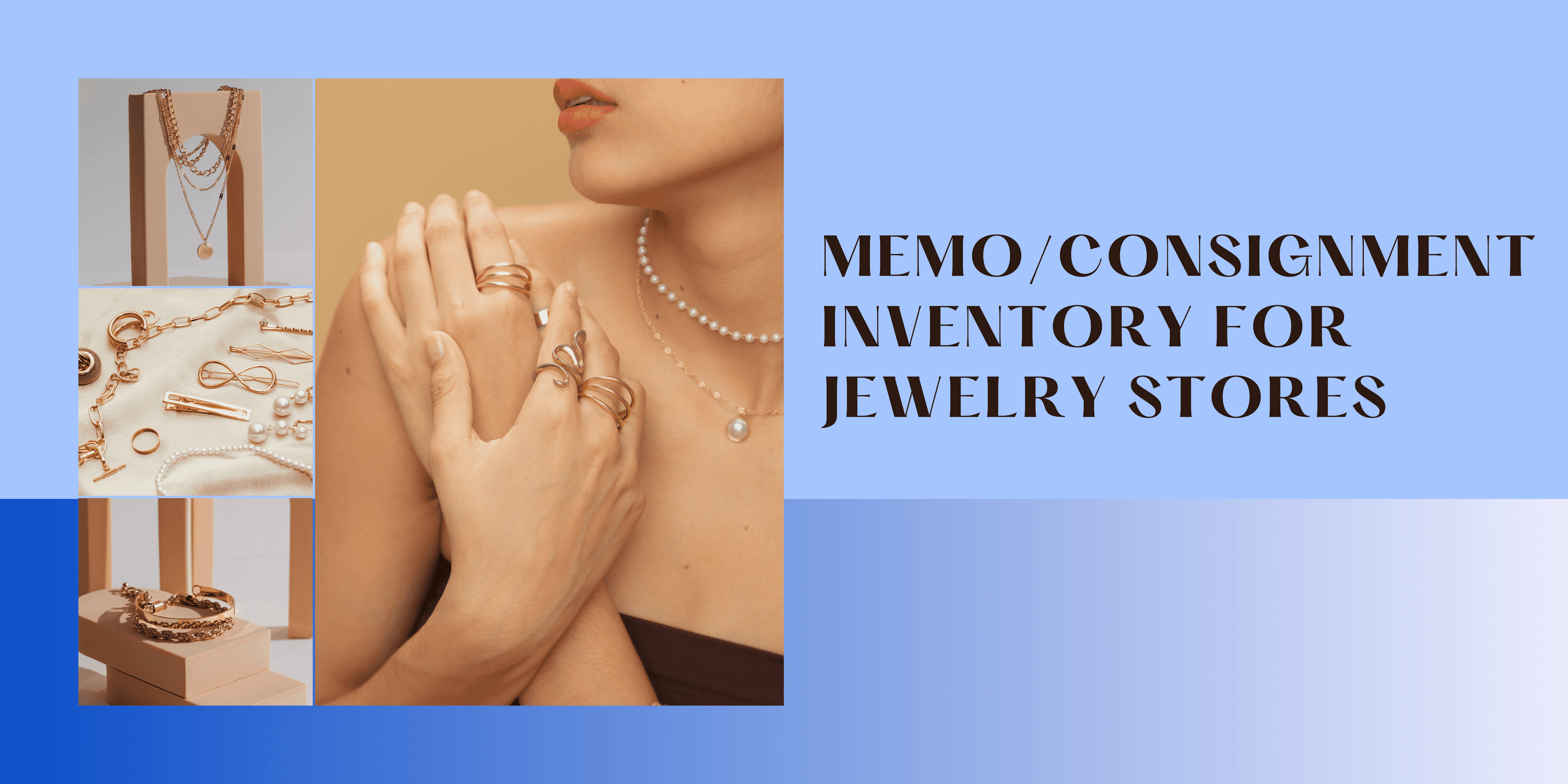
Memo/consignment arrangements are widely used in the jewelry industry for a good reason. When done right, they allow retailers to display a broader range of jewelry pieces without having to take any financial risk. This allows jewelry businesses to become more solvent and profitable. However, consignment can be risky (and costly) if mismanaged, potentially leading to financial penalties and loss of ability to set up such arrangements in the future. Let’s talk about memo/consignment inventory, its pros and cons and how to best manage it.
Understanding Memo/Consignment in the Jewelry Industry
So, what is memo/consignment inventory, and why do jewelers use it? Successful jewelry stores know they must keep their inventory fresh to attract customers and increase sales. But purchasing a wide variety of jewelry pieces outright can be a significant investment. Enter memorandum (memo for short) and consignment arrangements as a potential win-win for all parties involved.
Under such agreements, vendors provide retailers with jewelry pieces and require payment only when the retailers sell the pieces. The retailers display the memo pieces, allowing them to keep their inventory appealing and up to date. If the pieces remain unsold after an agreed-upon time frame, the retailers return the pieces to the vendors without having to pay the vendors. This allows jewelry retailers to stock a wider range of inventory and allows jewelry wholesalers to have faster inventory turnover.
The Benefits of Memo/Consignment Orders for Jewelers
When memo/consignment inventory is managed properly, it provides many benefits, including:
● Improved Liquidity: Memo sales only require you to pay for jewelry pieces once they are sold. This enables you to reduce the amount of cash your jewelry business has tied up in inventory. You can use this extra cash flow to spend on other business necessities such as marketing or non-memo inventory purchases. Improved liquidity also makes it easier for you to sell jewelry to your customers on layaway plans because of your improved cash position.
● Reduced inventory risk: The price of precious metals and stones changes meaningfully over time. If you buy your inventory without memo, your jewelry business will now have to take on the risk of commodity prices. This is a significant risk as prices of diamonds have fallen considerably in the past years and could mean you would have to sell your inventory below your cost value. Jewelry pieces can also become obsolete over time as trends evolve. This could mean you would have to scrap some items and resell them at a discount relative to your purchase price. Memo and Consignment agreements stipulate that you can return unsold inventory, this allows you to effectively mitigate such inventory risks by returning jewelry pieces that are below your cost level.
● Expanded product offerings: Given you do not have to pay for memo pieces until you sold them, you can significantly expand the number of jewelry pieces you carry. This new inventory will keep your inventory fresh and will allow you to sell more to your existing clients. You can also experiment by stocking different styles of jewelry than you typically carry and see if this can bring in a broader type of client to your jewelry store, which could grow your business.
● Greater flexibility: Memo’ed inventory allows you to experiment with various jewelry trends without carrying any significant risk (especially as trends come and go). For example, you could stock some items from newer trends and see how they perform. If they sell well then you can invest in them, if not, you can return them to the vendors without any losses.
The Risks and Challenges of Memo/Consignment Inventory
Memo/consignment inventory does, however, carry risks, some of which are outlined below.
● Strained vendor relationships: The reduced risk you face must be held by someone else, and that is the vendor providing the memo inventory. If you consistently fail to sell memo’ed jewelry inventory and return it to your vendors, then they can decide to stop supplying you. This is because such a relationship would be unprofitable for them.
● Inventory management: As your jewelry inventory grows, keeping track of your owned versus memo’ed inventory becomes increasingly difficult. You don’t want to have to tell your vendors that you have misplaced one of their pieces. Managing this will require good organization practices which takes time.
● Loss of memo privileges: Jewelry vendors often have strict requirements for memo purchases. If you fail to meet them, you might lose the opportunity to work with them on future memos/consignments. Avoid late payments, missing items, and poor communication.
● Financial penalties: If you fail to send payment for sales you’ve made in time, you’ll likely be penalized with fees. Similarly, if you fail to return an unsold item, you will likely have to pay full price for it.
Common Problems Jewelers Face with Memo/Consignment Management
While memo’ed jewelry inventory brings about many benefits, it can be quite complex to manage. It may require you to upgrade your operational processes due to the following challenges:
● Tracking inventory: While you might already have an inventory management system in place that can track pieces on a per vendor basis, it might not track memo and consignment arrangements. You would have to keep track of consignment and memo’ed inventory separately from your owned inventory. This is because your memo’ed inventory will have strict deadlines you need to stay on top of.
● Sales and payment tracking: The last thing you want to do is to upset a vendor by losing track of memo items you’ve sold. You need to ensure you have a system in place so you can track and pay your vendors once your memo items sell. Failing to do this will also cause you to have to pay hefty late fees.
● Return deadlines: Depending on your arrangement with vendors, you may have to pay a fee for late returns or even have to purchase memo’ed items outright if you miss your deadline. This would negate the benefits of memo arrangements, so it is essential to keep track of deadlines.
Failure to address these challenges can lead to memo’ed inventory being more problematic than beneficial. Fortunately, CaratIQ has a complete memo inventory management solution built for jewelry stores.
How CaratIQ Helps Manage Memo/Consignment Inventory
CaratIQ was built to address the shortcomings of outdated jewelry store inventory management systems. Here are five features that CaratIQ offers to help jewelry stores take in memo inventory.
Memo Item Tracking by Vendor
CaratIQ allows jewelry stores to track memo/consignment items by the vendors that supply them. Every memo item is logged into CaratIQ with detailed information, including vendor details, item specifications, and ownership status. This makes it easy to search items by vendor and quickly pull up vendor contact information from within an item.
Automated Reminders for Payments and Returns
CaratIQ provides automated reminders that ensure you never miss a vendor payment or item return deadline. For example, you can get alerts for upcoming payment due dates for memo items you’ve successfully sold. Similarly, you can receive return reminders to ship back pieces before return deadlines. These notifications will ensure you maintain strong vendor relationships.
Inventory Integration and Status Updates
CaratIQ seamlessly incorporates memo items into your inventory system by providing:
● Real-time updates: If you sell or return a memo item, its status is automatically updated in CaratIQ.
● Sales integration: Memo item sales are automatically linked to sales transactions and customer profiles.
● Stock visibility: Quickly see how much of your stock is owned versus on memo/consignment.
Reporting and Analytics
It is essential to have comprehensive reporting capabilities if you use memoe’d jewelry inventory. CaratIQ provides detailed reporting and analytics to help you understand your memoe’d inventory performance. For example, CaratIQ allows you to see your top performing memo’ed categories and vendors. This is helpful as it allows you to gain an understanding of the items you should stock on memo and which vendors you should source them from. CaratIQ also allows you to see the number of days items remain in inventory before being sold. This will give you a better idea of what memo deadline terms you should ask from your vendors.
Vendor Communication
The key to maintaining good vendor relationships is communication. That’s why CaratIQ has built in calling, emailing and texting features. This gives jewelry businesses the ability to quickly notify their vendors when they have sold memo pieces and share return shipment tracking details seamlessly.
Conclusion
Memo/consignment jewelry sales introduce significant operational complexities, but with the right software, they provide significant advantages. CaratIQ was built to empower jewelry businesses with the right tools to address the specific problems that memo and consignment inventory bring about. Click here to get a free demo of CaratIQ

You may also like
View all

